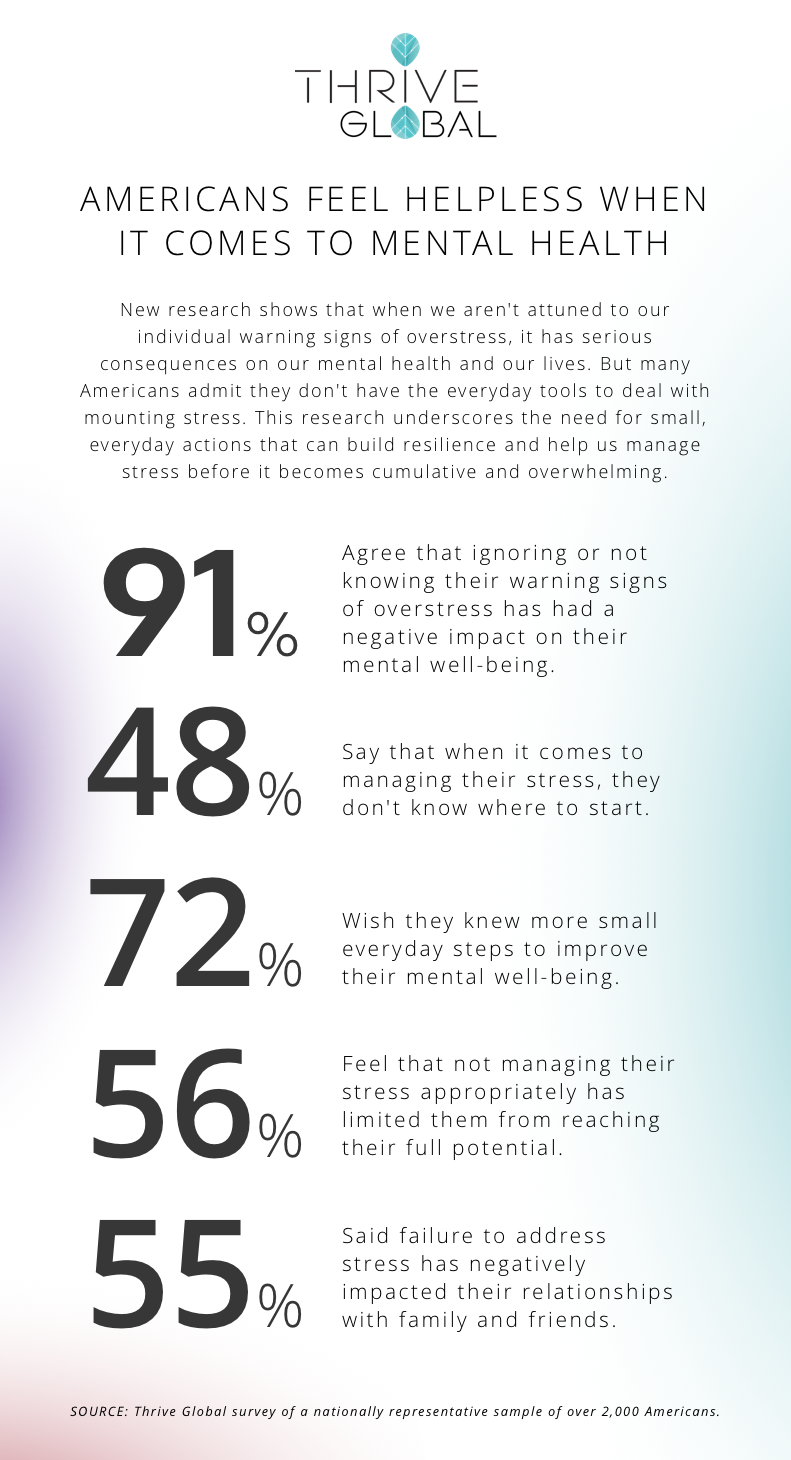The COVID-19 pandemic has vastly accelerated the mental health crisis that already existed before it. Thrive Global has surveyed over 8,000 Americans over the past month regarding the impacts of the COVID-19 pandemic, and 82% of individuals feel that the pandemic has had a bigger negative impact on their stress than any other event in history. And a report published in The Lancet warned that the mental health effects of the pandemic could “exceed the consequences of the 2019-nCoV epidemic itself.”
Research on the brain from Stanford Medicine is shining a light on the importance of spotting our warning signs of overstress so we can take meaningful steps to improve our mental health before stress levels become overwhelming. The problem is big, but the solutions start small. Consider this article a resource to help you understand your individual signs of stress, take small steps to recharge, and unlock better mental health.
From a young age, we’re conditioned to look for physical warning signs. If we feel a cold coming on or spot a rash, we schedule an appointment with a doctor to get it checked out.
But we’re not nearly as attuned to warning signs when it comes to our mental health — and that has serious consequences on our lives, new Thrive research shows.
Ninety-one percent of Americans say ignoring or not knowing their warning signs of overstress has had a negative impact on their lives, according to a new nationally representative survey of more than 2,000 people between the ages of 18 and 85. The areas that respondents said suffered most when they waited too long to address their stress are major contributors to our overall happiness and well-being: relationships with friends and family, mental health, physical health, and finances.

Not only did people say that ignoring signs of stress had a negative impact on their mental well-being, but most revealed they have no idea how to stop the situation from happening again and again. Nearly three-quarters of respondents said that they wish they knew more small everyday steps to improve their mental well-being, and nearly half admit that when it comes to managing stress, they don’t know where to start.
For Mental Health Month, organizations around the world are doing the important work of raising awareness around mental health issues. But these new statistics point to a desperate need for small steps to manage the impact of negative stress before it grows cumulative and overwhelming. So at Thrive, we’re focusing on action.
Pioneering research from Leanne Williams, Ph.D., the director of Stanford Medicine’s Precision Mental Health and Wellness Center, is shining a light on the importance of spotting our warning signs of overstress so we can take meaningful steps to improve our mental health.
Using high-definition brain MRI technology, Williams has identified eight different types of brain “short circuits” that can happen when we’re under extreme stress, which she calls biotypes. Biotypes occur when our brain circuits get “stuck” in a loop of thoughts, feelings, and behaviors we can’t get out of. For instance, the Rumination biotype happens when we’re unable to stop brooding over a negative experience or interaction, and Anxious Avoidance is the feeling of being overstimulated and driven to remove ourselves from situations causing us stress.
“These short circuits aren’t a form of weakness or a personality flaw,” Dr. Williams writes. “They’re biology interacting with our experience. And everyone experiences them at some point.” (Thrive Founder and CEO Arianna Huffington talks of recognizing herself in the Rumination biotype.)
Knowing about these biotypes can help us take action, because when we recognize patterns in ourselves in the ways we think, feel, and behave in moments of extreme stress, we can intentionally respond to our stress in ways that better serve us. We can learn strategies for building resilience and managing stress before it boils over and harms our mental health. Williams believes the more you understand about your own brain, the better equipped you are to live the life you want.
In this special section you’ll hear from celebrities like Taraji P. Henson and Melinda Gates, who are opening up about their own stressors, signs of overstress, and the small, everyday steps that boost their mental well-being. And you’ll find pieces from thought leaders offering upstream solutions for the mental health issues many of us face, including tips for dealing with anxiety in the workplace, financial stress, loneliness, the specific stress racial minorities face, and much more.
You may be wondering: So what are some of the actions I can take each day to protect and improve my mental health? Here are some science-backed tips that Thrive Global and Stanford Medicine have created together to help you identify your stressors, recognize your patterns and warning signs of overstress, and take action to improve your life. The first three tips are designed to help you identify your thought patterns under negative stress and adopt an action-oriented mindset. The Microsteps that follow will help you take action.
Identify one source of negative stress in your day.
Before you can solve a problem, you have to name it. Pinpoint just one experience or scenario in your daily life that routinely creates negative stress. Interactions with a certain person? A moment at home or at work that always seems to be rushed and unpleasant? Once you recognize a pattern, you can begin to take steps to prevent stress from becoming cumulative and unmanageable.
Think of your brain as a battery.
This simple metaphor will change the way you think about managing stress. When negative stress builds up, it drains your battery. But when you check your battery charge and choose a recharge strategy, you can course-correct before it leads to a mental health crisis.
Identify your stress response.
Each of us responds differently to negative stress. And learning to recognize your own thought patterns is the first step to making changes that will improve your life. Check out Dr. Leanne Williams’s breakdown of the eight biotypes here.
Take five minutes to write down the feelings and behaviors you exhibit under negative stress.
For example, do you feel overwhelmed, anxious, irritable, sad, worried, self-deprecating, panicked, numb, or like you want to run away? No one knows your stress response better than you, and writing it down will help you detect patterns so you can get proactive about managing stress.
If you find yourself judging your emotions or responses around the pandemic, remind yourself that they are normal and justified.
Studies have found that pathologizing your responses by viewing them as “something wrong with you for reacting so strongly” actually increases your anxiety. Instead, say something to yourself like, “You are going through a crisis, and you are reacting in a normal way to an abnormal situation.”
When you feel overwhelmed, focus on your breathing instead of reaching for your phone.
We often use our phones to distract us from challenging moments, but this often leaves us more stressed and more disconnected from what matters most. Allow yourself a moment to turn inward instead and focus on your breathing.
Set a news and social media cut-off time.
While being informed can help us feel more prepared in a public health crisis, setting healthy limits to our media consumption can help us have a restorative rest and put the stressful news into perspective.
Set aside one minute of recovery time after a stressful meeting.
You can build up to five minutes, but the important thing is to begin. Instead of returning immediately to your work, take a short, brisk walk, which will activate your senses and help modify your breathing, or just a few minutes of breathing. Consciously building in just a few minutes helps you to collect your thoughts, recharge, and bounce back from any challenges.
Observe your breathing when you open up your email in the morning.
Eighty percent of us hold our breath for short bursts of time while reading our emails, which disrupts our breathing and increases stress.
Take one minute at the start of the day to pre-empt negative stress with a positive affirmation.
An affirmation is a simple recharge strategy that helps you focus on the positive. Before you take on the day’s demands, identify a negative feeling and reframe it in your favor. For example, if you frequently feel judged (by yourself or others) for falling behind or not measuring up somehow, try: I am able to do everything that needs to be done. If you often feel overwhelmed or stressed, try: I am enough.
At the end of each day, recall one moment that caused you stress and reframe it.
Reframing is the active and intentional shifting of our mindset. It’s about pausing to intentionally take in the world through a different lens. Practicing reframing at the end of each day will strengthen your ability to put your stress in perspective and reframe in the moment.
Set aside a specific time each day or week dedicated to “worry time.”
Recent science shows that people who actually schedule time to worry reduce their anxiety, stress, and depressive symptoms significantly more than people using standard anxiety treatments. Make it five minutes or 15 minutes, whatever you need. Any amount of time you can commit to is worthwhile. Write down or reflect on your worries and concerns.
Choose an in-the-moment technique for moments when you begin to worry or ruminate.
It might be a moment of breathing, reframing, or reciting your positive affirmation. You’ll reduce stress in the moment and remind yourself to revisit something causing you stress during your scheduled worry time.
A few minutes before bed, escort your devices out of your bedroom.
You’ll decrease the mind clutter and anxiety that come with a stressful day. Disconnecting from the digital world will help you sleep better, deeply recharge and reconnect to your wisdom and creativity.
Take 10 minutes to journal or meditate before bed.
To quiet the mind and prepare for sleep, try listing out what you are grateful for, reframing stressful situations in your day, jotting down goals or to-dos for the next day, or simply free writing your thoughts and feelings (sometimes called a “mind dump”). This will help clear your mind of mental clutter and unwanted thoughts or ruminations.
Invite a friend or colleague to a virtual lunch or coffee break.
Consider going deeper on a few connections you currently have. Inviting someone you already know to a virtual lunch or coffee and getting to know them in a deeper way is important for building human connections that optimize brain function, and is good for your mental and physical well-being.
This content is informational and educational, and it does not replace medical advice, diagnosis or treatment from a health professional. We encourage you to speak with your healthcare provider about your individual needs, or visit NAMI for more information.
Read more of our mental health coverage here. And here are three other mental health resources: Ginger, Lyra Health, and Omada Health.
Follow us here and subscribe here for all the latest news on how you can keep Thriving.
Stay up to date or catch up on all our podcasts with Arianna Huffington here.


